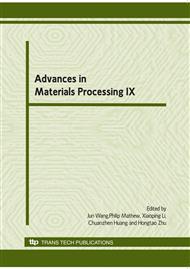p.177
p.183
p.189
p.195
p.201
p.207
p.213
p.219
p.227
Reciprocating Shaving Approach to Eliminate Crack and Burr Formations in Pressed Parts
Abstract:
Burrs are unwanted materials remaining not only after the machining operation but also after the sheet metal cutting operation. Burr formations decrease the part accuracy and increase the cost for the deburring operation. In this study, the reciprocating shaving process was proposed to eliminate crack and burr formations in the pressed parts. The finite element method (FEM) was used as a tool to investigate the possibility of this process and its working process parameters as well. The FEM simulation results showed the effects of clearance in shearing operation, shaving allowance, and half-shaving direction on the shaved surface. These results were validated by laboratory experiments, and they showed a good agreement with each other. The FEM simulation could be used as a tool for prediction of the cut surface in the reciprocating shaving process. The results revealed that the reciprocating shaving process could be applied for eliminating crack and burr formations in pressed parts using suitable working process parameters.
Info:
Periodical:
Pages:
201-206
Citation:
Online since:
June 2010
Keywords:
Price:
Сopyright:
© 2010 Trans Tech Publications Ltd. All Rights Reserved
Share:
Citation:


